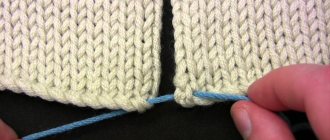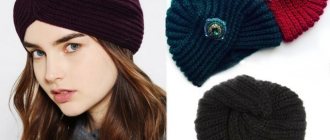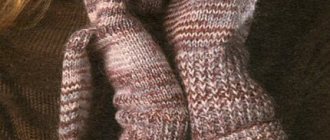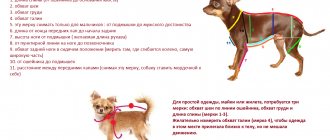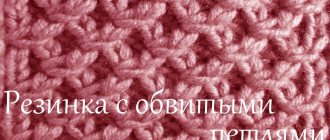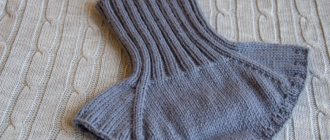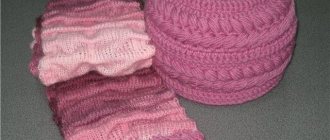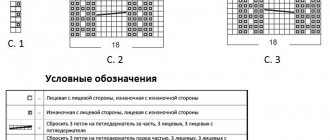Beanie hat - what is it?
In English, beanie means round hat. As a rule, this is a plain, calm headdress, without unnecessary accessories, fittings and fasteners.
Beanies first appeared in the last century in England. Comfortable hats were used by workers - mechanics, assemblers, electricians. Gradually, the fashion for hats spread to children - schoolchildren and students.
Beanie hat for a boy with dancing bears
A wonderful beanie hat with jacquard for a boy aged 1.5 or 2 years. To enlarge the photo, click on the arrow in the lower right corner.
Who is the beanie hat for?
Today, the beanie hat has climbed to the top of the fashion Olympus. She has conquered absolutely all categories; now both children and adults are happy to introduce fashionable models of hats into their wardrobes.
Its huge advantage is that its shape suits absolutely all face types, which cannot be said, for example, about berets or caps. It is enough to experiment with changing the volume, color or adding a small lapel.
Do not forget that this is just a headdress and it can not only be a fashionable item of clothing, but also with great success protect from frost and winds.A wide variety of yarn will help you choose exactly what you need.
General color trend
Children's hats look best made from yarn of bright and rich colors - red, yellow, bright blue, green. Contrasting inserts and chic buboes would be appropriate in the children's version.
Men's ones are made in restrained colors - black, gray, dark blue tones.
Women's hats include all color shades, mostly depending on the preferred style of clothing and the age of the beautiful housewife.
Beanie style
Today's fashionable hat fits perfectly into all styles of modern life. Sports, casual and even classic - you can choose your own hat for any style.
Note!
- How to crochet a mouse and a rat: video master class on crocheting the 2020 symbol
How to knit a warm hat with ears for a newborn boy and girl - video tutorials with patterns, instructions for beginners
How to crochet a beautiful scarf: video master class on creating unusual, beautiful, simple scarves for boys, girls, men and women
Play with colors and make a wonderful selection of your favorite things. As options, we bring to your attention a small selection that will allow you to imagine what the headdress looks like in different images:
- You have a long coat collecting dust in your wardrobe. Try putting together an outfit with a coat, trainers and a beanie.
- In early spring, when the sun is just starting to get hot, but it’s still quite cold outside, wear a light beanie hat complete with sunglasses. This technique looks really cool!
- Another spring look is a combination of wide leg-length trousers with classic shoes, your favorite light coat and a beanie hat.
- In winter, together with your fur coats and down jackets, a beanie hat with a wide scarf will become a stylish and trendy solution.
So, are you convinced that beanie hats will fit perfectly into your wardrobe and have you learned how to wear this item? Don’t hesitate and quickly learn how to properly knit something new for yourself.
Tire pattern diagram.
We knit even rows according to the pattern. In practice, it turns out that all rows are repeated 2 times. The hat itself is knitted exactly the same as the Fourth option.
Beanie hat with pattern. Here is a hat from our reader.
Selection of knitting needles and threads for a hat
Once you have decided what time of year you will wear the hat, under what things and in what places, you can come close to choosing the material.
For the winter season, it is recommended to make a hat from angora or cashmere - these are natural materials. If you are planning to knit a hat for an adult, then you can also look towards artificial materials - bamboo fiber, acrylic and polyester.
In the demi-season period, threads made from half-wool, merino and cotton will be relevant. Thin merino threads will allow you to create a warm and fairly thin hat, ideal for the off-season. Cotton hats are ideal in early autumn and late spring, because... They are unlikely to be able to protect your head from the cold.
Note!
How to knit a hat with a lapel using knitting needles or an elastic band: step-by-step instructions for beginners
How to crochet a winter hat: 95 photos of new models of warm, fashionable, original knitted hats with a lapel and a beautiful pattern
- Light and beautiful crochet shawl: photos of chic openwork scarves with simple patterns
Once you have chosen a yarn, carefully examine its label. The label usually indicates the number of knitting needles that are recommended for this type of yarn. Carefully study the photos of labels and do not hesitate to ask questions to the consultants. If no information is found, then follow the rule - the thickness of the knitting needle should be one unit greater than the thickness of the thread.
To work you will need straight or circular knitting needles. Which ones exactly will depend on the pattern. If the hat requires a seam, then you should take straight ones; for a seamless one, circular ones are ideal.
Various hats
The particular popularity of hats entails the appearance of various variations. Check out the new products and decide what suits your head best. Classic solutions or newfangled trends, the choice is yours.
Facial surface
A beanie made with stockinette stitch looks simple and impressive; this model is especially interesting in its seamless version.
For a size 57 hat, take number 4 circular knitting needles with fine yarn (100 grams per 350 m length).
We invite you to familiarize yourself with a short master class:
- 132 stitches are cast into a circular stitch.
- The hat is knitted in stockinette stitch until the height reaches 24 cm.
- All loops are divided into 4 parts. Each part contains 33 loops.
- We perform the formation of the crown - 1 row and the next odd ones at the beginning of the wedge, the first knit stitch, then 2 together, then all knit stitches, leaving the last two wedges on the knitting needles. The penultimate loop must be removed, the last one must be knitted and threaded through the penultimate unknitted one. This is done for each of the 4 parts.
- 2 and subsequent even loops are performed completely with knit stitches without decreasing.
- After 3 loops remain on the knitting needles, you can finish your work, tighten the loops with working thread and carefully hide them on the wrong side.
- To decorate such a rather simple hat, choose the most beautiful crown in a specialized store. You can attach it to the hat using a button or simply sew it on, it all depends on the material of the top and your imagination, because when you use a button you can purchase several tops for one hat!
LiveInternetLiveInternet
Quote from Lioness_A
Read in full In your quotation book or community!
Double knitted hats are very relevant in the cold winter. It's time. They are not only less susceptible to strong winds, but also very fashionable and stylish. There are quite a lot of options for making such hats.
The easiest way is to knit in satin stitch on stockinette and circular knitting needles, starting from the top or bottom. The choice of yarn depends on the season and model: winter hats are knitted from yarn with a high wool content, spring hats are knitted with acrylic.
Very beautiful and warm hats are made by knitting one or two-sided jacquard with patterns of flowers or geometric elements.
Double hats with one-sided openwork are very beautiful and popular. This can be decorated as one element of the openwork in the form of a heart or butterfly, or one side is completely knitted with openwork knitting from a contrasting thread.
Reversible cap
author of the model curaewa a
The hat is knitted from children's whim yarn, one skein of each color. Needles number 3. Can be worn with a lapel. Cap for head circumference 56-58.
First, cast on the loops on the hook in the same way as in the video.
Then knit in a circle of 17 cm and close the loops by dividing the total number by 4. That is, I had 140 loops, we divided by 4 and it turned out to be 35. Place markers between these 35 loops. Then we subtract 5 from 35 and get 30. Divide 30 by 2 and we get 15. We knit 15 loops, then unfold 2 loops and knit together for the back loops, one front loop and two loops together for the front walls.
Then it’s exactly the same. The next row is just a front row. Then we knit 14 stitches, a decrease, one knit and a decrease, etc. When there are 20 stitches left on the knitting needles, pull them off and tuck in the tip. Then we remove the auxiliary thread and put these loops on the knitting needles. Knit another 23 rows so that there is a lapel and knit the next row purlwise. Then change the color and continue knitting in the same way. Double hat with jacquard pattern.
Prepare woolen or half-woolen threads and knitting needles numbered No. 3. The knitting density will be 10 by 10 cm = 27 sts by 35 rubles.
The main pattern is represented by faces. satin stitch and jacquard pattern, which is knitted according to the pattern. The unfolded double cap looks like a hollow pipe, and there are round bottoms on the sides.
It is advisable to cast on the loops using a double-sided method so that they are open. Knitting can take place both on circular and straight knitting needles. Only after knitting a double hat with straight knitting needles will you have to join it with a seam at the back of the head. You need to start knitting from the middle of the product. In the figure, the middle is indicated by a red line.
Cast on the loops that you must calculate according to the volume of your head.
Then knit thirty-seven centimeters of faces. iron. If your hat is knitted in the round, then work all the stripes with knit stitches. If you knit on straight knitting needles, then alternate rows of purl and knit stitches.
After this, knit a jacquard pattern on one side of the hat. The hat is almost ready. Now you need to knit the round bottoms. To make them without numerous folds and bends, reduce the links through each row of eight pieces. Decrease the stitches until you only have ten stitches left, which are then cast off.
This completes the master class, and the hat can be worn on both sides. On one side there will be a jacquard pattern, and on the other - plain knitting, which can be varied at will with an English elastic band or braids. These hats can be knitted with any pattern of flowers or stripes. Double hat with 2x2 elastic knitting needles.
Materials:
Yarn BBB Rekord 50g*175m, 100% merino wool. It took 200g (4 skeins). Knitting needles No. 2.5.
For head circumference 54cm 200p, for head circumference 56cm - 208p. Knit on 5 needles No. 2.5 in the round with an elastic band, knit 2, purl 2. Knit 14 rows.
Next we knit the pattern. 1 row. *k2, p1, leave p1 behind work, knit 1, knit p1 with aux. knitting needles, leave k1 before work, knit 1 purl, knit 1 knit. with auxiliary knitting needles, p1* - repeat from* to*
2nd row. *K2, P1, K1, P2, K1, P1.* repeat from * to *
3rd row. *k2, leave p1 behind work, knit 1, knit 1 purl. with aux. knitting needles, p2, leave k1 before work, knit p1, knit k1 with auxiliary needles* - repeat from * to *
4 row. *k3, p4, k1* - repeat from * to * Knit 10 rows as the 4th row.
15th row. *P2, leave k1 before work, p1, knit k1 with aux. knitting needles, p2, p1 leave for work, k1, p1 with auxiliary. knitting needles.* - repeat from * to *
16th row. *p2, p1, k1, p2, k1, p1.* repeat from * to *
17th row. *p2, p1, k1 left before work, p1, knit 1 with spare needle, purl 1 left behind work, k1, p1 with spare needle, p1* - repeat from * to *
Row 18: P4, K2, P2. Next knit 66 rows. satin stitch
Top of the head. Purl *2 stitches together. P25* - repeat from * to *.
The next row is purl stitches.
In the next row there are 24 stitches between decreases, and in each subsequent row there are 1 less stitches until there are 15. Decrease rows alternate with purl stitch rows. When there are 15 decreases, make decreases in each row. Through the last 16 p. thread the thread and tighten. Double warm hat with a pattern of plaits.
The hat is knitted from 200g wool yarn, knitting needles No. 4.
empty square = knit from the front side, purl from the back side square with a cross = knit from the wrong side, purl from the front side two squares together, crossed out by a line from the upper right corner to the lower left = slip one stitch on a spare needle behind the work, knit 1, purl 1 from a spare needle, two squares together, crossed out by a line from the upper left corner to the lower right = slip one stitch onto a spare needle at the front of the work, 1 purl, 1 knit from a spare needle, two squares together, half shaded with a black triangle = slip one loop onto a spare needle behind work, knit 1, knit 1 from a spare needle, six squares along with an “arrow” pointing up (M3) = slip three stitches onto a spare needle behind the work, knit 3, knit 3 from a spare needle, six squares along with an “arrow” pointing down ( M2) = slip three stitches onto the spare needle at the front of the work, knit 3, knit 3 from the spare needle.
Knitting pattern:
Double cap knitted with open stitches.
How to knit a hat using open stitches:
Cast on the required number of loops using any thread (preferably in a contrasting color) in the usual way, cut the thread, then take the thread from which we will knit the hat and start knitting the first row with this thread in any way that is in the photo.
When you knit the outer cap, we return to the beginning of knitting, pick up the loops of the first row from the wrong side (they will be clearly visible, of a different color), and unravel the auxiliary thread and knit the inner cap in the other direction.
We cast on 138 loops on a pair of knitting needles (of slightly different thicknesses) using brown thread, using the open method. On one side we got knit stitches, on the other we got purl loops. We leave the loops on one pair of knitting needles and start working on the other: -lock off and knit in the circle using stockinette stitch with brown thread. We knit with the expectation that this part of the hat should go slightly inside at the collar. Therefore, the height of this gateway must be added to the main height.
From the start of knitting with brown thread to the start of decreases, I got 59 rows. Now we put off knitting the top hat and move on to the bottom one. We attach the milk thread and knit it with knitting needles No. 2 (we do not change the number of knitting needles, but the thickness of the thread is much thinner) and knit the entire lower cap. We need this in order to know exactly at what height to start decreasing the top cap. We knit 50 rows in a circle. Then we decrease, knitting 2 stitches together, in this way (you can do it in any other way convenient for you, I decided to do it this way): 51st row, every 11th loop we knit 2 stitches together; 52nd row all knits (further we knit all even rows with knits); 53rd row, every 10th loop we knit 2 stitches together* *and shifting the count a little so that the decreased loops are not on top of each other; 54th row all persons. 55th row, every 9th loop we knit 2 stitches together*; 56th row all persons. 57th row, every 8th loop we knit 2 stitches together*; 58th row all knits 59th row every 7th loop we knit 2 stitches together* 60th row all knits.; 61st row, every 6th loop we knit 2 stitches together* 62nd row, all knits. 63rd row, every 5th loop we knit 2 stitches together* 64th row all knits 65th row, every 4th loop we knit 2 stitches together*; 66th row all knits 67th row every 3rd loop we knit 2 stitches together*; 68 row all knits 69th row we knit every 2nd loop 2 together knit 70 row all knits 71st row we knit each loop 2 knit together Cut the thread, thread the thread into the needle and transfer the remaining loops to the needle, tighten and fasten end of the thread.
We try on the hat, look and proceed to the top hat.
Divide the knitting into 6 wedges and in every 3rd row decrease 2 loops in each wedge (3 loops together with the knit one).
Reversible double beanie with four wedges. Be sure to knit a swatch to figure out how many stitches to cast on. Measure your head, minus 3 cm for fit. This is the length of the chain of air loops. If we knit with yarn 100 g = 350 m and knitting needles No. 4, then:
Using hook No. 6, we cast on a chain of 106 air loops with an additional thread (we will then cut it and throw it away). From the groove of this chain we use a knitting needle to cast on 104 loops of the same color. We knit 20 cm in stockinette stitch (more is possible). Then we start decreasing. We will decrease it in 4 places.
(How to calculate where? 104:4=26, 26:2=13)
13 loops, hang a marker, 26 loops, hang a marker, 26 loops, hang a marker, 26 loops, hang a marker. We will decrease before and after the marker through the row.
When there are 8-10 loops left on the knitting needles, pull the crown together and cut the thread on the wrong side. Half of the hat is ready.
Take a thread of a different color and return to the chain of air loops. We don’t make any knots yet, we just put the second color thread into the work. There is a path there with the thread that was just used to knit. We lift the loops of this track onto knitting needles No. 3. We knit a couple of rows with a thread of a different color. We tie two threads. We hide the tails inside the hat. Now you need to remove the extra thread. If everything was done carefully, it will stretch out easily, but if not very well, you will have to work hard. We get rid of the excess thread. Next we knit 20 cm in stockinette stitch and decrease in the same way as with the first color thread. Pull and cut the thread. Hide the tail inside out.
Double hat with an openwork top. The hat is knitted double, but on any color, an openwork pattern in the form of a heart, a butterfly or any other pattern of your choice is knitted on any color from one or two sides. The hats whose top is knitted entirely from openwork look beautiful.
Hat on OG 58 cm, hat height 23 cm Materials: Vita Brilliant yarn 2 colors, skein weight: 100 g, thread length: 380 m
Composition: 45% wool (laster), 55% acrylic Recommended knitting needle size No. 2.5 - 3.
Open cast on 132 stitches. For ease of decreases in the future, the number of loops should be a multiple of 4.
Start knitting the selected openwork pattern at a height of 1-2 cm from the fold.
Knit 18.5 cm in the round. Next, divide all the loops into 4 parts and knit decreases. Knit like this: 1 row. 2 together with a tilt to the left, 1 knit, 2 together with a tilt to the right, 28 knit, 2 together with a tilt to the left, 1 knit, 2 together with a tilt to the right, etc. 2nd row. All knit rows 3 are the same as the first, only the number of stitches between decreases is 26. Knit like this until there are only 20 stitches left on the knitting needles. Tie them together with thread. This is a classic way to decrease. The decrease was 8 cm.
Then knit a hat in a different color in that direction from the open stitches of the cast-on. Double hat with openwork top "Rime".
The bottom layer of Hermitage in 3 threads (70% merino, 30% cashmere, 750 m/100 g) yarn, the top layer of angora 80% (700 m/100 g) in one thread. Main needles 4, and finish the openwork by reducing the size of the knitting needles, here all of them come in handy arsenal from 4 to 2 Weight 70 g.
The pattern can be of your choice.
Tips for knitting double hats:
- Inner hats can be knitted from thinner yarn or the same threads, but take knitting needles 1 size larger. The number of loops is 2-3 less than for the main cap.
- Cast on the loops on the wrong side of the main hat until it is sewn and knit 3-4 rows shorter than the main one.
- When decreasing the stitches, you can knit the last two stitches together at the end of each wedge. The path between the wedges will be one less loop, and in the last decrease there will also be two loops together.
- You can make the hat deeper; to do this, knit a longer straight section of the fabric. To reduce the depth, the straight section should be knitted shorter.
- You can make the hat larger or smaller in circumference; accordingly, it will sit on your head a little looser or a little tighter (this is a matter of taste). To increase, add the same number of loops in each wedge. To decrease, reduce.
Nice fold on the double cap.
1 way
Cast on 2 times fewer loops than needed, knit 3-4 rows in stockinette stitch, then knit 1 knit stitch and 1 purl loop from the first row broach, but only knit from the second row broach, and then knit the lining from the first row broaches - 1 loop from the broach of the first row + 1 yarn over, etc.
Method 2
You can knit 1 row completely purlwise, and the fabric bends well along this row. Or you can do it with cloves - 2 knit stitches together + 1 yarn over. It also looks beautiful, but you have to do some magic to fit the elastic bands into the design. Types of decreases on the crown.
Decrements for the top of the head in hats and in the inner ones are done according to the same principle: All loops are divided into 6-8 parts and decreases are made (the number of loops is indicated for example): 1 chrome, 1 knit, 2 together by pulling, 10 knit. p., 2 together, broaching, 10 knits. p., continue until the end of the row. Next persons row: 1 chrome, 1 knit, 2 in broach, 9 knit. p., 2together, knit 9. p., continue until the end of the row. Next persons row: 1 chrome, 1 knit, 2 in broach, 8 knit. p., 2 together, broaching, 8 knits. p., continue until the end of the row. Decrease until there are only 2 stitches left between each row; in this row, knit all stitches 2 together by pulling through and in the next row. Purl row once again knit all loops 2 together.
Decrease with 2 loops in the middle:
You can sequentially decrease twice along the loop and place one or two loops between these decreased loops. In the first decrease, we first unfold both knitted loops and knit them together “from ourselves”, in the second we knit two loops together with the front one. Make the next decrease after three or four rows, the next after two or three, several decreases through a row, at the very top of the head several in a row.
Decrease 3 stitches together:
divide the knitting into 4-6 wedges and in every 3rd row decrease 2 loops in each wedge (3 loops together with the front loop and the central loop).
Knit three loops together with a front loop with a central loop: the loops are rearranged so that the second loop is on top of the first.
To do this, use the right knitting needle to hook the first two loops out of three behind the front walls and throw them onto the right knitting needle, then return these loops to the left knitting needle: the loops are turned upside down, and the second loop lies on top of the first. Then all three loops are knitted behind the back walls.
Reduction scheme:
Secrets and nuances of a good fit. Closing the loops with chamomile.
Author: Natalya Savchenkova
The hat should fit close to the head, not stretch into a “skirt” and hold on without moving down. How to achieve this in a double cap? There are three ways to do this: - processing with a hollow cord (i-cord) along the bottom of the cap: two canvases are fixed, the hollow cord keeps the edge from stretching; - double hem, and inside there is a hat elastic: it fits well to the head, covers the ears; - imitation of a band (elastic band) due to more dense knitting of the bottom of the hat: we knit from the bottom up, gradually increasing the number of knitting needles. And all of the above is described in more detail in the video:
source
Voluminous beanie hat with knitting needles: description and diagram step by step
Large knit beanies are very popular this year. You can knit a hat from thick yarn very quickly; experienced needlewomen can do it in a few hours.
A voluminous and beautiful hat will go perfectly with any style of clothing, and if you add it with a scarf, you will have an excellent set. Bulky threads do not need an additional pattern; stockinette stitch, garter stitch, or simple elastic are suitable.
For example, for a size 52 hat, take threads (100 grams per 40 meters in length) and number ten circular knitting needles. It is proposed to knit a white cap, because... white color will add additional volume and will look good with any things.
- 46 stitches are cast into a circular stitch.
- With a simple elastic band (1 knit alternates with one purl) knit 36 rows.
- In the next 5-6 rows we make a uniform decrease by knitting 2 loops together.
- After 14 loops remain on the knitting needles, you will need to pull the working thread through them and fasten the crown.
- Pull the remaining thread to the wrong side. The hat is ready.
Options for finishing knitting
Option 1
You can finish the hat by knitting wedges. Having knitted 1/3 of the product, we begin to finish knitting. You need to think in advance about the number of wedges on the top of your head. If you decide to make four wedges , then divide the remaining loops on the knitting needles by four. If there are eight wedges, then divide by eight, etc. If the loops in the wedges are unequal, we add them for equality.
After this, we begin to decrease the loops every three rows. But you can decrease it more often or less often, it all depends on the volume of the head, as well as the type of hat. It can be tight-fitting to the head or, conversely, elongated. Reducing the number of stitches is done by knitting two stitches together before each wedge. Remove the remaining loops in the wedges onto a strong thread and pull tightly.
You will find one of the options for knitting a hat from start to finish in this video.
Option 2
Let's consider the option of knitting without knitting wedges.
Having knitted a third of the product, we begin to reduce the number of loops. To complete the crown in the front row, all loops are doubled with front loops. Then you need to knit 3 cm with one knit stitches and then reduce by doubling, as at the beginning of knitting. When the desired length is reached, remove the remaining loops and fasten them.
Other ideas
Let's look at some interesting additions to complete the header:
- Scythe. Cut about 10 threads. Their length is determined individually at will. You need to fold them into a bun, fasten them at one end and place them in the top hole of the cap. Sew with thread from the wrong side, pull tight and tie.
- Pompon. To make a pompom, you need to twist wool threads around two cardboard circles. Then cut the threads along the outer edge, tie with a strong thread between the circles, leaving the ends.
- Brush. A tassel is made from a bunch of threads. It is tied in the middle with a loop, then bent in half and wrapped again with threads below the base.
Hat with lapel
The lapel will decorate your hat and make it unusual. It is proposed to knit a hat with a lapel on circular knitting needles. Any pattern is suitable for this hat - plaits, braids, elastic bands. It is recommended to take fairly thin yarn (100 grams per 500 meters of length), knitting needle number 5.
Product description size 54:
- 70 loops are cast on in a circular manner.
- A 35 cm lapel is knitted with an English elastic band.
- Knit 4.5 cm with a regular elastic band (1 knit, 1 purl).
- Forming the crown - loops are knitted two together. In the next row, bring the working thread through the loops, remove one without knitting and knit the next 2 loops into one. Do this until there are 16 stitches left on the knitting needles.
- Tighten 16 loops with working thread and secure. Bring the end of the thread to the wrong side.
Beanie hat with a simple elastic band 2 by 2
A stocking cap with 2x2 elastic knitting needles is a great opportunity to knit a hat for yourself in 1 evening. Elastic band 2 by 2 - knits without problems, if you take thin knitting needles - the product will look like the store-bought version.
Knitting hats pattern gum 2 * 2
Classic beanie
For the classic model, a popular and simple knitting pattern is initially used - garter stitch. Such a beanie made of threads with such characteristics would look great - 100 grams of thread in 110 meters. As a tool, select straight knitting needles number eight.
Garter stitch will be appropriate not only in women's, but also in men's clothing. Garter stitch is often used in children's products.In order for the hat to better hold its shape, you can use a double thread when knitting.
Features of knitting
Beanies are knitted or hand-knitted hats that do not have fasteners or ties. They can fit tightly around the head (hat-sock) or be elongated (stockings), and the width of the products can also vary (tight-fitting or oversized).
You can knit a beanie, like a regular hat, from the bottom up. But more often a special approach is used here:
- knitting begins from the side - the lower and upper edges of the finished product will be tucked into the back seam of the cap;
- to ensure the narrowing of the cap at the top, you need to knit the wedges using the method of shortened rows;
- When creating such elements, the technique of entwining loops is used.
The work can be done with crochet, but beanie hats are more often knitted with knitting needles.
Beanie hat knitted description and diagram step by step - photo ideas from the best craftsmen
Please repost
0
